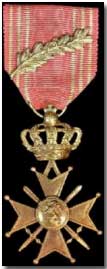Encyclopedia - Belgian Croix de Guerre
 The Belgian Croix de Guerre
(or War Cross) was instituted on 25 October 1915 as a means of formally
recognising acts of heroism performed by individuals (of any of the Allied
powers) during the First World War.
The Belgian Croix de Guerre
(or War Cross) was instituted on 25 October 1915 as a means of formally
recognising acts of heroism performed by individuals (of any of the Allied
powers) during the First World War.
The medal was also awarded to recognise a period amounting to three years of front-line Belgian service (plus other circumstances, e.g. volunteers above age 40 with at least 18 months service in a combat unit).
The medal could only be earned by foreign nationals for acts of heroism conducted while on Belgian soil. Comprising a bronze cross the medal featured crossed swords and a disc bearing a rampant lion, the whole suspended from a bronze crown. The reverse of the medal bore the letter 'A' denoting King Albert I.
The medal was awarded by differing levels of command; depending upon the awarding command level the appurtenance worn on the ribbon differed. A bronze palm indicated that the medal was awarded by the army; the presence of a bronze lion that the medal was awarded by a regiment; and a gold lion denoted that the medal was issued by land forces. The ribbon was red with five green stripes.
The medal was reinstituted for use during the Second World War in 1941.
An Armlet was a cloth band worn around the arm to identify a particular duty or function.
- Did you know?
